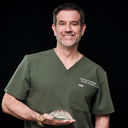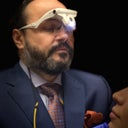While the exact term for how your scars have healed can be debated, the main thing for you is that they don't look good, and you want them to be improved while avoiding the chance that this will happen again. They are now 1 year old, so they have in fact healed, and the healing is for the most part complete and mature. I agree with your surgeon that they are not true keloids, insofar as keloid scars extend beyond the limits of the original injury. Keloids would be huge, raised, thick, and growing onto normal skin adjacent to the actual incision site. What you have are called "hypertrophic scars," and they also are "hyperpigmented," or darker than normal too. This is sort of on the spectrum of wound healing, but technically and under the microscope, there is a difference between keloids and hypertrophic scars. The significance of this for you is that people that form keloid scars get them due mostly to hereditary factors, and they are far more likely to have recurrent keloid scars with any subsequent injury, including surgical scar revision, whereas in cases of hypertrophic scarring like yours, there may be an excellent chance that it can be avoided or managed postoperatively with scar revision. Scars can become hypertrophic for a variety of reasons, including genetic skin type or hereditary factors, sun exposure, amount of tension on the skin edges at wound closure, type of sutures used, suturing techniques used, precision with which the original incision was made and how it was placed, and postoperative forces on the healing scars. Some of these things can be changed or managed with further treatment, and some can't. For instance, if we attempt surgical revision, we can modify our technique so that we make a properly oriented incision in the skin, close it meticulously and without too much tension, and then use things like silicone gel sheet afterwards. We can also treat postoperatively with a special type of laser to prevent the scar from becoming hypertrophic. This requires a very specific type of laser though, and the right expertise in using it, so not everyone has that available. There are also some non-surgical measures that can be attempted before proceeding directly to surgical scar revision too. There are medications including steroids and cell division inhibitors usually used to treat cancer but used in tiny doses for scars, like mitomycin C or 5 Flourouracil (5-FU), which can be injected into the scar directly, and they will often achieve very nice improvement without surgery, but again, they have to be used properly because they can cause some issues with the scars if incorrect dosing or technique are employed. In the end, your surgeon knows what techniques were used for your first surgery, and therefore, they know where those techniques could possibly be altered this time around if surgical revision is attempted. They will also know whether or not it is advisable to try a non-surgical option first before proceeding to surgery, as they are there to examine your scars in person. You can discuss these things with your surgeon though so that you fully understand all of your options and where they stand on them. Good luck.










